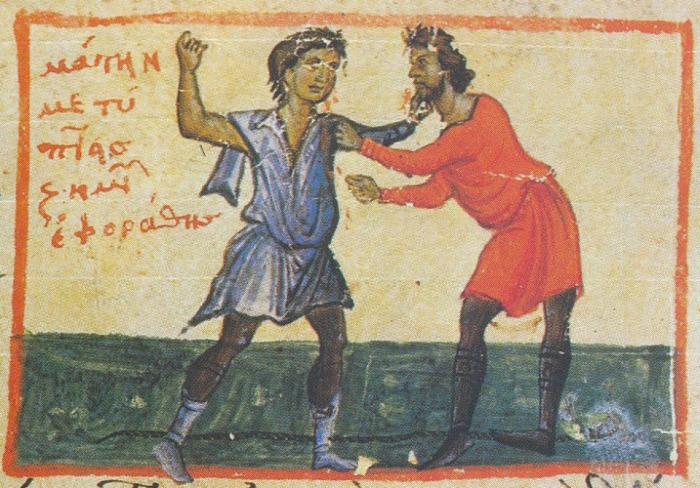
By Kostas Dervenis
George Georgas recently published an article on Byzantine boxing I found interesting, primarily because the accompanying illustration depicted two boxers utilizing what I used to call the “Hellenic fist”. This fist is a staple of Pammachon, and it is time to bring it to the public’s attention.
I first took note of this fist in the Odyssey, during Odysseus’ fight with the beggar Irus. This was an interesting duel where Homer clearly describes the difference between the warrior and the brawler in one concise paragraph
:
[Book 18, 88] So he spoke, and thereat yet greater trembling seized the other’s limbs, and they led him into the ring and both men put up their hands. Then the much-enduring, godly Odysseus was divided in mind whether he should strike him so that life should leave him even there as he fell, or whether he should deal him a light blow and stretch him on the earth. And, as he pondered, this seemed to him the better course, to deal him a light blow, that the Achaeans might not take note of him. Then verily, when they had put up their hands, Irus let drive at the right shoulder, but Odysseus smote him on the neck beneath the ear and crushed in the bones, and straightway the red blood ran forth from his mouth, and down he fell in the dust with a moan, and he gnashed his teeth, kicking the ground with his feet.
‘ὣς φάτο, τῷ δ᾽ ἔτι μᾶλλον ὑπὸ τρόμος ἔλλαβε γυῖα.
ἐς μέσσον δ᾽ ἄναγον: τὼ δ᾽ ἄμφω χεῖρας ἀνέσχον.
δὴ τότε μερμήριξε πολύτλας δῖος Ὀδυσσεὺς
ἢ ἐλάσει᾽ ὥς μιν ψυχὴ λίποι αὖθι πεσόντα,
ἦέ μιν ἦκ᾽ ἐλάσειε τανύσσειέν τ᾽ ἐπὶ γαίῃ.
ὧδε δέ οἱ φρονέοντι δοάσσατο κέρδιον εἶναι,
ἦκ᾽ ἐλάσαι, ἵνα μή μιν ἐπιφρασσαίατ᾽ Ἀχαιοί.
δὴ τότ᾽ ἀνασχομένω ὁ μὲν ἤλασε δεξιὸν ὦμον
Ἶρος, ὁ δ᾽ αὐχέν᾽ ἔλασσεν ὑπ᾽ οὔατος, ὀστέα δ᾽ εἴσω
ἔθλασεν: αὐτίκα δ᾽ ἦλθε κατὰ στόμα φοίνιον αἷμα,
κὰδ δ᾽ ἔπεσ᾽ ἐν κονίῃσι μακών, σὺν δ᾽ ἤλασ᾽ ὀδόντας
λακτίζων ποσὶ γαῖαν.’
Odysseus uses a hooking left punch to deliver the blow, his body
swivelling as Irus strikes his right shoulder. But the accuracy of the
blow is such that he strikes into the gap next to his opponent’s mastoid
process with precision, his “light blow” traumatizing one subclavian
artery and inner ear and dropping the man to spasm on the ground. It is
not clearly stated by Homer, but the only way such a blow could be
delivered with exactitude is with the first knuckle of the left hand,
preferably with an extended digit (otherwise it is difficult for the
fist to strike this target). This type of rotational motion, in fact
this technique itself, is incorporated into the 5th basic movement of
Pammachon.ἐς μέσσον δ᾽ ἄναγον: τὼ δ᾽ ἄμφω χεῖρας ἀνέσχον.
δὴ τότε μερμήριξε πολύτλας δῖος Ὀδυσσεὺς
ἢ ἐλάσει᾽ ὥς μιν ψυχὴ λίποι αὖθι πεσόντα,
ἦέ μιν ἦκ᾽ ἐλάσειε τανύσσειέν τ᾽ ἐπὶ γαίῃ.
ὧδε δέ οἱ φρονέοντι δοάσσατο κέρδιον εἶναι,
ἦκ᾽ ἐλάσαι, ἵνα μή μιν ἐπιφρασσαίατ᾽ Ἀχαιοί.
δὴ τότ᾽ ἀνασχομένω ὁ μὲν ἤλασε δεξιὸν ὦμον
Ἶρος, ὁ δ᾽ αὐχέν᾽ ἔλασσεν ὑπ᾽ οὔατος, ὀστέα δ᾽ εἴσω
ἔθλασεν: αὐτίκα δ᾽ ἦλθε κατὰ στόμα φοίνιον αἷμα,
κὰδ δ᾽ ἔπεσ᾽ ἐν κονίῃσι μακών, σὺν δ᾽ ἤλασ᾽ ὀδόντας
λακτίζων ποσὶ γαῖαν.’
The extended knuckle fist was widely used in ancient Greece and there are multiple examples of diversified use of the concept. For example, we can see the particular fist under discussion in the Parthenon marbles, where an unfortunate Lapith uses it to strike the spleen of an assailant Centaur on one of the frescos in the British Museum. Extended knuckle fists were utilized in Ancient Greece with a single digit extended, with all four knuckles extended, or with a closed fist in a “diamond” formation.
The particular fist we use in Pammachon has the first digit of the hand extended. The fist tightens by coiling in the rear three fingers, starting from the pinkie. The thumb sits straight on top of the coiled three fingers and locks the extended first finger into place.
A clear example can be seen in the figure in George’s article on Byzantine boxing; therefore it would be appropriate to label this particular application the “Byzantine fist” as opposed to my earlier choice of appellation. What is interesting in this particular case is that both brawlers are using the fist.

Δεν υπάρχουν σχόλια:
Δημοσίευση σχολίου